ISSN ONLINE(2320-9801) PRINT (2320-9798)
ISSN ONLINE(2320-9801) PRINT (2320-9798)
Ms.R.Vaishnavi karthika1, Mr.M.N.Karuppusamy2
|
| Related article at Pubmed, Scholar Google |
Visit for more related articles at International Journal of Innovative Research in Computer and Communication Engineering
Underwater wireless sensor networks (UWSNs) is essential for an investigators. It requires time synchronization service or a lot of applications. However, in order to do time synchronization in UWSNs, three issues have to be considered. A first, acoustic channel features long propagation delays, which make the conventional two-way delay measurements quite inefficient and inaccurate. Second, since all nodes change continuously with water currents, underwater networks are a highly dynamic network, which makes the synchronization protocols for static networks are not suitable here. Last but not the least, the underwater nodes are usually charged by power unit, for which it is hard (if not impossible) to get replaced. Synchronization protocols which need frequent message exchanges do not fit here. A new brand time synchronization algorithm, TSROD is specifically designed for mobile UWSNs. In TSROD, the spatial correlation of the sensor node mobility is effectively employed to improve the accuracy of the estimation of the fast-changing long propagation delay. In addition, the ratio of valid reference messages is much higher than other synchronization protocols, which makes TSROD quite energy efficient. Furthermore, with multiple runs of linear regression as well as the calibration process, both skew and offset is well estimated and compensated. To handle time synchronization error, kalman filter or averaging filter estimate the unknown variable means target location in underwater containing random error which greatly increases the accuracy of the time synchronization algorithm.
Keywords |
| UWSNs, Synchronization, Sensor node, Kalman filter. |
I. INTRODUCTION |
| UWSN addresses the time synchronization problem in any sensor network. A large number of time synchronization protocols are designed for terrestrial sensor networks. Their synchronization accuracy and energy efficiency is cogent. This is not suitable in underwater sensor networks, which suffers from low propagation speed, sensor node mobility. There is lack of serviceability, batteries are difficult to recharge. There is different time synchronization algorithm for UWSN including Mobi-Sync, TSHL, MU-Sync and D-Sync. These algorithms solve the long propagation delay. For example, Mobi-Sync does not solve the error TSHL is designed for fixed networks; MU-Sync is not energy efficient; D-sync overlooks the effect of skew and offset. To overcome the limitation of existing approaches, TSROD estimate the long propagation delay among nodes. It consists of three phases: delay estimation, linear regression, kalman filtering. Phase I gathers information about spatial correlation of the sensor nodes. In phase II, sensor nodes perform linear regression to obtain skew and offset. Phase III performs kalman filter to minimize error rates in underwater. The result improves accuracy as well as energy efficiency. |
II. RELATED WORK |
| In the literature, there are different time synchronization protocols like terrestrial sensor networks. |
| Time Synchronization for High Latency Acoustic Network (TSHL) is designed for static networks. TSHL addresses long propagation delay an energy consumption issues. It involves two way message exchanges to calculate skew and offset. TSHL suffers from sensor node mobility. |
| Mu-Sync: A Time Synchronization Protocol for Underwater Mobile Networks (MU-Sync) is cluster base UWSN. The cluster head manages the process of time synchronization. It determines the number of reference messages, calculate the skew and offset and performs linear regression twice.MU-Sync has high message overhead. It involves significant error when sensor node mobility fast. |
| D-Sync: Doppler based Time Synchronization for Mobile Underwater Sensor Networks (D-Sync) considers the Doppler shift caused by node mobility in underwater environment. By estimating and compensating the Doppler shift, it improves the accuracy of the long propagation delay. It needs special hardware for underwater communication which is not a complete solution. |
III. PROBLEM DEFINITION |
| 3.1 Existing System |
| In the existing system, it accurately estimate the long propagation delays to improve accuracy as well as energy efficiency with minimum overhead of message. Mobi-Sync performs linear regression to obtain skew and offset to improve accuracy of propagation delay. But it does not investigate error in underwater so it limits the accuracy. |
| 3.2 Proposed System |
| 3.2.1 Basic Architecture diagram of Underwater Sensor Networks |
| Underwater sensor network architecture is shown in Fig. 1. It consists of three types of nodes: surface buoys, super node and ordinary node. |
| Surface buoys: Surface buoys are equipped with GPS (Global Positioning System) to obtain global time references and perform localization. They act as the “satellite” nodes in underwater environment. |
| Super nodes: Super nodes are powerful sensor nodes; act as reference clocks, super node synchronize with surface buoy. Moreover, super nodes estimate speed as they can directly communicate with the surface buoys to obtain real time location and global time information. |
| Ordinary nodes: Ordinary nodes are the sensor nodes become synchronized. They are inexpensive and low complexity. Ordinary nodes cannot make direct communication with surface buoys and can only communicate with their neighboring ordinary nodes or super nodes. The battery lifetime of ordinary node is limited. |
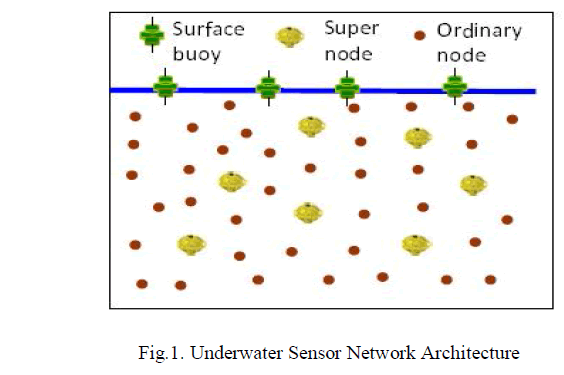 |
| 3.3 Proposed Method |
| TSROD describes with three phases. Fig. 2 shows the description between ordinary nodes and super nodes. The ordinary node estimate propagation delay then performs linear regression to obtain skew and offset and reduce error by performing kalman filtering or averaging filter. |
| 3.3.1 Propagation Delay Estimation |
| Fig. 3(a) shows one run message exchange. The ordinary node send request message to the super node. Upon receiving, each super node schedules with two response messages. Message contains the recorded velocity of the super node and its time-stamp. |
| Most existing Wireless Sensor Network (WSN) operating systems use First Come First Serve (FCFS) schedulers that process data packets in the order of their arrival time. |
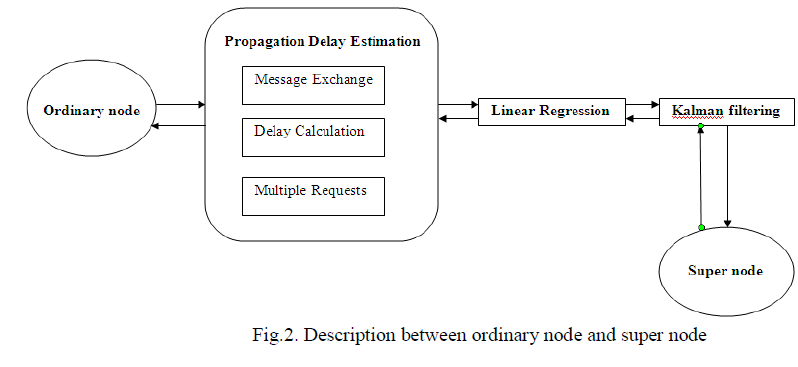 |
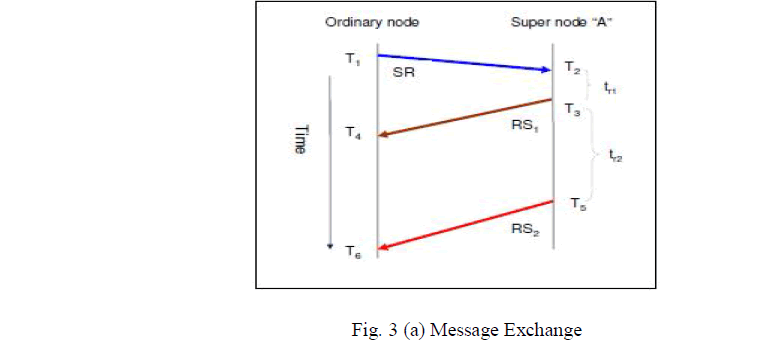 |
| 3.3.1.2 Delay calculation: |
| In Delay calculation, the distance between two response time tr1 and tr2 is calculated |
| 3.3.1.3 Multiple requests: |
| Based on its accuracy, the ordinary node iteratively runs the synchronization process. Each request follows the sequence step described above. For each super node, the ordinary collects a set of time stamp T3, T4, T5 and T6 as well as the propagation delay of message exchanges. |
| 3.3.2 Linear Regression |
| In phase II, the ordinary node runs the linear regression to estimate the draft clock skew and offset. This regression involves the weighted least square estimation (WLSE) reduces the outlier’s impact. |
| 3.3.3 Kalman filter |
| The kalman filter is used in large number of fields. It is recursive algorithm to estimate the unknown variable containing arbitrary errors. The unknown value is the target location represented by (x, y, z) in underwater space. Kalman filter estimate the target location and describe all possible mobility pattern. It sends time-stamp only at the particular area. |
| 3.3.4Averaging Filter |
| Kalman filter estimate the accuracy by reliability of the system modeling. Averaging filter does not need system modeling instead of it estimates the current as the observed state. |
| Finally, the super node discovers the ordinary node through total number of times multi-lateration and error correction with filter as described above. After the super node update their location in real time using INS to get latest about the ordinary node. At last the localization improves accuracy. |
IV. SIMULATION |
| In the simulation, 10 super nodes and 30 regular sensor nodes are randomly deployed in a 100 m *100 m * 100 m region. One ordinary node is randomly picked as the sample node wishes to synchronize with its neighboring super nodes. Without loss of generality, the inherent skew of this ordinary node is defined as 50 ppm, and it maintains unchanged during the time synchronization procedure. The clock offset of this ordinary node is initialized as 0.8*10-4 s. Additionally, the predefined parameter tr1 is set to 2 ms, and ti is 1 ms. The propagation speed in the simulated environment remains constant at 1,500 m/s. The kinematic model characterizes the mobility behavior. |
 |
| where Vx determines the speed at X axis, Vy stands for the speed at Y axis. k1, k2, k3, v are variables, which are closely related to environment factors such as tides and bathymetry. These parameters change with different environments. Random variables k4, k5 simulate additional random physical factors. In our simulations, we assume k1, k2 to be random variables which are subject to normal distribution with ÃÂ as mean values and the standard derivations to be 0.1ÃÂ. k3 is subject to normal distribution with 2ÃÂ as mean value and the standard derivation to be 0.2ÃÂ. λ is subject to normal distribution with 1 as the mean value and 0.1 as the standard derivation. Table 1 shows the numerical values for the mean and variance of these variables. |
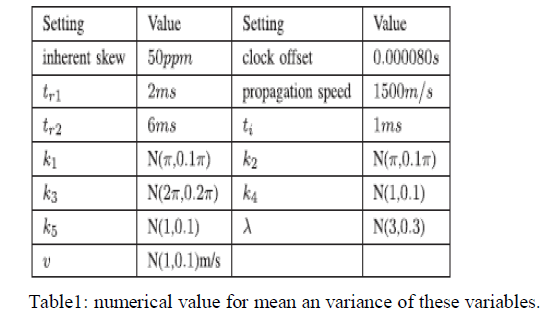 |
V. RESULT AND ANALYSIS |
| Fig. 4 shows the simulation result. In this simulation, TSHL and MU-Sync need fifty timestamp for the accuracy on skew estimation. But TSROD uses twenty timestamp between nodes. So the error is less than zero. |
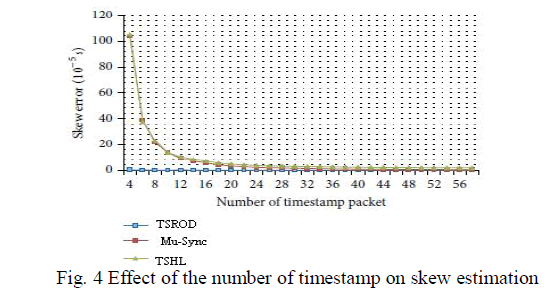 |
| Fig. 5 shows the effect of channel access delay on offset estimation. From the simulation result, TSROD provide more reliable timestamps no matter how many nodes are done for channel occupation. Fig. 6 shows the error in time measurement. The accurate time estimation has benefits in terms of saving energy. |
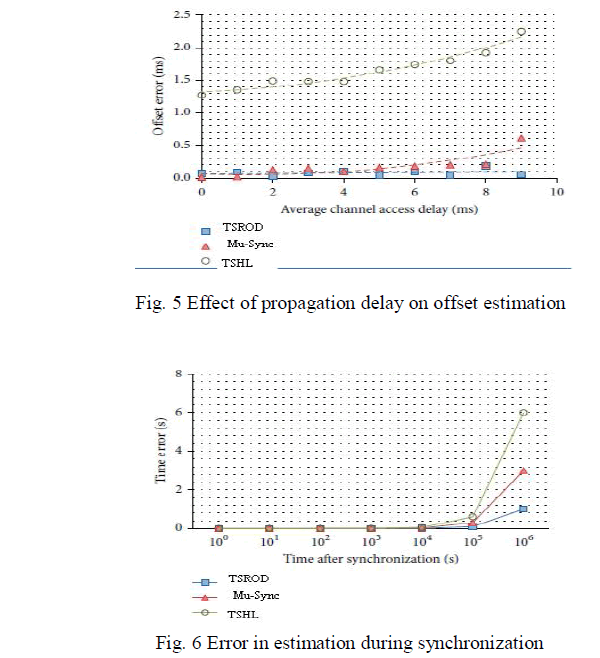 |
VI. CONCLUSION |
| TSROD estimates the long propagation delay and perform linear regression to obtain skew and offset and minimize error by performing kalman filter. So it improves accuracy as well as energy efficiency. The simulation shows that this approach achieves high accuracy with low message overhead. |
| In future, the work will be extended to localize mobile objects and investigate the future algorithm for mobile patterns and combine TSROD with them. |
VII. ACKNOWLEDGEMENT |
| It is my pleasure to acknowledge Mr.P.Bala kumar, Sixsquaresystems, Chennai for his support in implementation part and for his guidance throughout this course of work. And also wish to thanks our principal Mr. Babu Senathipathi and our staff Mr.M.Arul Prakash those who inspire me to write this paper. |
References |
|